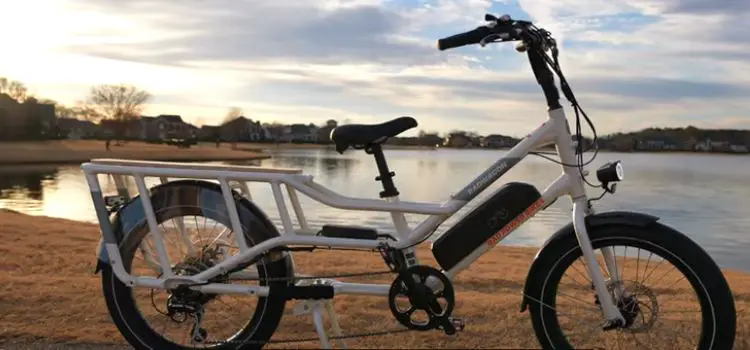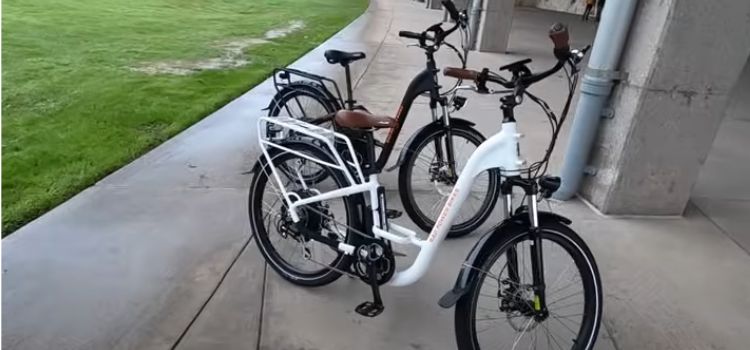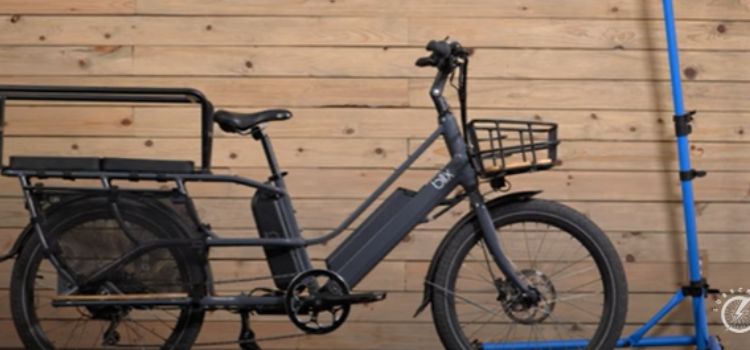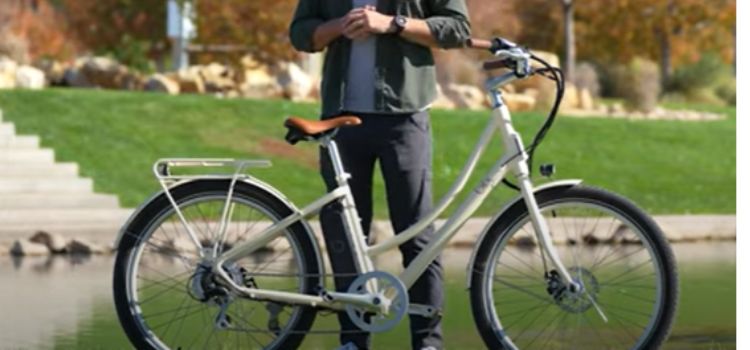Flyer L885 vs. Radwagon 4: Which E-Bike Should You Buy?
As an Amazon Associate I earn from qualifying purchases.
E-bikes have revolutionized the way we commute and explore our surroundings, offering an eco-friendly and efficient alternative to traditional bicycles. As the demand for e-bikes continues to soar, two standout models have gained significant attention: the Flyer L885 and the RadWagon 4.
In this article, we will delve into the key features, unique selling points, and overall performance of each model, followed by a comprehensive head-to-head comparison to help you make an informed decision.

Comparison Table Of Flyer L885 and RadWagon 4
| Feature | Flyer L885 | RadWagon 4 |
|---|---|---|
| Motor Power | 500W brushless hub motor | 750W geared hub motor |
| Battery Capacity | 48V 15Ah (687Wh) Lithium-Ion | 48V 672Wh Lithium-Ion |
| Battery Range | 30 – 50+ miles per charge | 24-45+ miles per charge |
| Frame Material | 6061 Aluminum | 6061 Aluminum |
| Top Speed | Up to 20 MPH | Not specified |
| Pedal Assist Levels | 5 levels with cadence sensor | 5 levels with 12-magnet cadence sensor |
| Throttle | Half twist throttle | Half twist grip throttle |
| Cargo Capacity | Not specified | Rear rack capacity: 120 lbs |
| Cargo Features | N/A | Running boards (optional accessory) |
| Display | LCD with speedometer, battery level, etc. | Backlit LCD with multiple indicators |
| Lights | LED headlight, integrated tail light with brake | Front: Rad Power Bikes branded LED, Rear: Integrated taillight with brake light indicator |
| Brake Calipers | Tektro Aries MD-M300 | Tektro Aries MD-M300 |
| Gearing | 7-speed derailleur | 7-speed Shimano |
| Weight | 73 lbs | Total: 76.7 lbs (with battery) |
| Recommended Rider Height | 4’10” – 6’6” (Small to Large sizes available) | 5’1″ – 6’4″ (One frame size: 13.5″) |
| Price | Check Price On Amazon | Check Price On Amazon |
Flyer L885: Unveiling the Powerhouse E-Bike
Introduction
As the world embraces the electric revolution in transportation, the Flyer L885 emerges as a formidable contender in the e-bike market. This section will scrutinize the key features, unique selling points, and the pros and cons of the Flyer L885, providing an in-depth exploration of its capabilities and potential areas for enhancement.
Key Features
1. Motor Power and Performance
The Flyer L885 is equipped with a robust 500W brushless hub motor, ensuring a powerful and efficient ride. This motor not only delivers impressive acceleration but also contributes to the overall performance and responsiveness of the e-bike.
2. Battery Capacity and Range
Powering the Flyer L885 is a 48V, 15Ah (687Wh) UL-tested lithium-ion battery pack with Samsung 50E 21700 cells. This high-capacity battery translates into an estimated range of 30–50+ miles per charge, providing a reliable and long-lasting energy source for various riding scenarios.
3. Frame Design and Build Quality
Crafted from durable 6061 aluminum, the Flyer L885 boasts a sleek and sturdy frame design. This not only enhances the bike’s aesthetics but also contributes to its overall durability and stability, ensuring a reliable and safe riding experience.
4. Speed and Efficiency
With a maximum speed of up to 20 mph, the Flyer L885 strikes a balance between speed and efficiency. This makes it an ideal choice for urban commuting and recreational rides, offering a swift and enjoyable journey while maintaining energy efficiency.
Unique Selling Points
1. Specialized Technology or Design Feature
The Flyer L885 distinguishes itself with specialized technology, including a 5-level pedal assist with a cadence sensor. This advanced system tailors the level of assistance to the rider’s pedaling, optimizing efficiency and making the e-bike adaptable to various terrains.
2. Target Audience and Use Cases
Geared towards urban commuters and enthusiasts, the Flyer L885 is designed for individuals seeking a reliable and efficient mode of transportation. Its versatile features make it suitable for daily commutes, weekend adventures, and everything in between, catering to a broad audience with diverse use cases.
Pros and Cons
Pros
- Powerful motor for smooth and efficient performance.
- Integrated front and rear lights
- Sturdy and aesthetically pleasing frame design.
- Balanced speed and efficiency, suitable for diverse riding scenarios.
Cons
- Reduction in overall weight for enhanced portability.-
- Kickstand isn’t easy to use
RadWagon 4: A Versatile Companion for Your Journey
Introduction
In the realm of electric bikes, the RadWagon 4 emerges as a versatile companion, blending power, design, and functionality. This section will delve into the key features, unique selling points, strengths, and potential areas for improvement of the RadWagon 4, providing a comprehensive overview of what this e-bike has to offer.
Key Features
1. Motor Power and Performance
The RadWagon 4 boasts a 48V, 750W geared hub motor with a 5:1 planetary reduction. This powerful motor ensures efficient performance, and its actual power-to-ground wattage, under 750W, aligns with regulatory compliance, offering a reliable and compliant riding experience.
2. Battery Capacity and Range
Equipped with a 672 Wh battery, the RadWagon 4 provides an estimated range of 24-45+ miles per charge. This substantial battery capacity ensures a consistent and dependable power source for both short commutes and longer journeys.
3. Frame Design and Build Quality
The RadWagon 4 features a robust 6061 aluminum frame, offering durability and stability. The frame design incorporates thoughtful elements, making it suitable for carrying cargo and adding an extra layer of functionality to the e-bike.
4. Speed and Efficiency
With a design that balances speed and efficiency, the RadWagon 4 is capable of providing a swift and enjoyable ride. This makes it suitable for various riding scenarios, from daily commutes to leisurely weekend rides.
Unique Selling Points
1. Specialized Technology or Design Features
The RadWagon 4 stands out with its intelligent 5-level pedal assist, featuring a 12-magnet cadence sensor. This technology ensures a seamless and responsive riding experience, adapting to the rider’s pedaling cadence for optimal efficiency.
2. Target Audience and Use Cases
Geared towards riders with diverse needs, the RadWagon 4 is designed for versatility. Its cargo-carrying capacity makes it an ideal choice for families, commuters, and those looking to transport goods, catering to a broad audience with varied use cases.
Pros and Cons
Pros
- Stable and Damp Ride Quality.
- Good distance range.
- Tons of Available Accessories
- Substantial battery capacity for extended range.
- Sturdy frame design with cargo-carrying capabilities.
- It is versatile for various riding scenarios.
Cons
- Consideration of weight distribution for improved handling.
- Recall Issues.
Flyer L885 vs. RadWagon 4: A Head-to-Head Battle of Electric Titans
Motor Power and Performance
The Flyer L885 boasts a potent 500W brushless hub motor, emphasizing a smooth and efficient ride. In comparison, the RadWagon 4 takes it up a notch with a robust 750W geared hub motor, designed specifically for cargo applications. The Flyer L885 excels in general performance, while the RadWagon 4 dominates in sheer power, especially when carrying heavy loads.
Verdict: Choosing between these models depends on your primary usage. If you prioritize general riding and versatility, the Flyer L885’s 500W motor offers a compelling option. However, if you need a powerhouse for cargo transportation, the RadWagon 4’s 750W motor takes the lead.
Range and Battery
The Flyer L885 impresses with a commendable 30–50+ miles per charge, ensuring long rides without constant recharging. On the cargo-centric side, the RadWagon 4 provides a slightly lower but still substantial range of 24-45+ miles. The Flyer L885 excels at offering an extended range, catering to riders with longer commutes or a penchant for exploration.
Verdict: For those seeking extensive range for daily commutes or recreational rides, the Flyer L885 emerges as a strong contender. On the other hand, if your journeys involve shorter distances and cargo hauling, the RadWagon 4 provides ample range for your specific needs.
Design and Build
Both models feature high-quality aluminum frames, ensuring durability and longevity. The Flyer L885 focuses on a sleek and versatile design, suitable for a wide range of riders. In contrast, the RadWagon 4 prioritizes stability and strength, evident in its cargo-carrying capabilities. The Flyer L885 offers adaptability, appealing to riders with diverse preferences, while the RadWagon 4 caters to those who prioritize cargo capacity.
Verdict: Consider your primary usage; if you need an adaptable bike for various scenarios, the Flyer L885’s design is a winner. However, if you prioritize cargo transport and stability, the RadWagon 4’s robust build takes the lead.
Features
The Flyer L885 stands out with its innovative pedal-assist technology and a half-twist throttle, providing a customizable and accessible riding experience. Meanwhile, the RadWagon 4 shines with cargo-friendly features, including a rear rack capacity of 120 lbs and running boards capable of holding 30 lbs per side (optional accessory). The Flyer L885 offers innovation for personalized riding, while the RadWagon 4 caters to practical cargo needs.
Verdict: Consider your riding priorities; if you desire personalized and innovative features, the Flyer L885 is the way to go. For those focused on cargo transport, the RadWagon 4’s specialized features make it a compelling choice.
Winner of the comparison?
The winner of the comparison between the Flyer L885 and RadWagon 4 ultimately depends on your specific priorities and intended use. Let’s break down the scenarios to help you make an informed decision:
If you prioritize general riding versatility, extended range, and personalized features:
- Winner: Flyer L885.
Reasoning: The Flyer L885 excels at providing a smooth and efficient ride with a powerful 500W motor. Its impressive battery range of 30–50+ miles per charge caters to riders with longer commutes or those who enjoy extended recreational rides. The innovative features, such as customizable pedal-assist technology, make it an attractive option for riders seeking a versatile and personalized experience.
If you prioritize cargo transport, stability, and specialized features:
- Winner: RadWagon 4
Reasoning: The RadWagon 4 is designed specifically for cargo applications, featuring a robust 750W motor and cargo-friendly elements such as a rear rack with a capacity of 120 lbs and running boards. If you need an e-bike for transporting goods, groceries, or even passengers, the RadWagon 4’s cargo-centric design and intelligent pedal-assist system make it a standout choice.
Amazon and the Amazon logo are trademarks of Amazon.com, Inc, or its affiliates.






